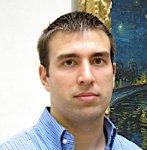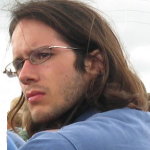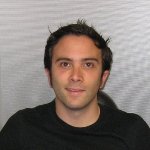|
Andres ABAD RODRIGUEZ |
CERN, Geneva - Switzerland |
 |
When I arrived at CERN in 2007, I worked during a year in the control system group of IT in the Gas Control System for the LHC. Since September 2007, I am working for the European project ETICS. It provides a system for the configuration, building, testing and integration of software. We have a web interface and a command line client from where our users, like Glite, can manage their configurations, submit builds and tests and get their results (binaries and reports) in a repository. We have introduced recently the possibility of send multinode tests. Inside the team, I am responsible for some modules of our web application (Java/J2EE and AJAX with GWT), the webservices (AXIS) and the database (MySQL). |
|
Nicola CHIAPOLINI |
Universität Zürich - Switzerland |
|
|
I have been working for the TT sub-detector of LHCb during both my Bachelor
and my Master thesis. Since January I am back with my previous group as a
PhD student. At the time of this writing my work concentrates mostly on the
detector alignment. |
|
Luigi GALLERANI |
CERN, Geneva - Switzerland |
|
|
My current work is in virtualization using the OracleVM technology, and adapting it to the CERN cluster infrastructure management system. This provides a transparent and Quattorised integrated layer of virtual Red Hat Enterprise and Scientific Linux machines for virtual IT-DB services hosting. I have an indepth knowledge in Networking and in GNU/Linux Operating Systems, which I use in the development of these virtualization solutions. Collaborating with the CERN openlab and using a multiprocessor computer, I am also studying the OracleVM performances. The aim of this task is to find the best load balancing configuration for the services that will run on the new cluster machines. I have good experience in OS scripting languages, imperative and OO-programming, in particular the C family. My MSc Thesis and previous work at the LHCb, gave me also skills in real time SCADA system programming. I have also become a CERN guide, and in learning more about the Particle Physics Experiments, have been able to help educate visitors. |
|
Carlos GARCIA FERNANDEZ |
CERN, Geneva - Switzerland |
|
|
Coming from Spain, I studied at the University of Oviedo. Thanks to them I got the opportunity to come to CERN as a Project Associate. During this first period at CERN, I was developing and maintaining the configurations in the infrastructure of CERN network, migrating from CISCO Firewall to IPTables Firewall. As well I was giving support to FlexLM License Management system, and using CERN Fabric Management Infrastructure (http://cern.ch/quattor) to fully automate installation and maintenance of some servers, managing Linux RPM’s software distribution and installation systems. One year later I got an openlab Fellowship in which I am currently working and my tasks consists in the integration of Oracle VM server within CERN infrastructure. I have been working in the integration at the host level in CERN ELFms (the large scale management system) and currently I am working in the integration at the guest level, as well as the migration of application and database servers to these virtual machines. I am familiar with Unix/Linux environments, as well as Windows. I have been working with shell, perl, scripting programming, and I like to program as well in Java and Web technologies. |
|
Belmiro Daniel RODRIGUES MOREIRA |
CERN, Geneva - Switzerland |
|
|
I finished in 2004 a BSc degree in Mathematics lectured at UTAD – Portugal,
and in 2009 a Integrated MSc degree in Informatics and Computer Engineering
lectured at FEUP – Portugal. Currently I'm working at CERN in the IT-PES
group in two different virtualization projects that covers the two big use
cases which have been identified at CERN:
the service
consolidation project and the batch virtualization project.
The first project aims to achieve the traditional benefits of service
consolidation like: decoupling hardware and system image lifetime, reduce
the power requirements, maintenance advantages, etc. With the batch
virtualization project the main objectives
are: dynamic change of worker node types dependent on requirements;
customization of images for specific use cases, possibility to mix virtual
and real resources, etc.
We were able to run more than 15000 VMs managed by OpenNebula in ~500
hypervisors, to evaluate the LSF scalability. Also, I am involved in the
evaluation of the Infrastructure Sharing Facility (ISF) tool by Platform
Computing and participate in the HEPIX working group, particularly in the
image distribution schema. I'm familiar with various virtualization and
cloud technologies. |
|
Frank VOLKMER |
Bergische Universität Wuppertal- Germany |
|
|
In the last months I gradually took responsibility for maintaining the ATLAS Production System Dashboard which monitors all ATLAS tasks, where they are executed, how much cpu time they use end whether they are successful or not. The ProdSys Dashboard uses the Dashboard Web Framework, which was written in Python and developed at CERN. The dashboard runs on an Apache + mod_python system at CERN. This work includes the fixing of bugs and solving problems as they arise, as well as maintaining the dashboard and carrying its technology into the next decade. We, the dashboard team, started working on a new system that will use newer, more dynamic web technologies. This will help to generate new content for the dashboards more easily. From my previous work in the private sector and at university I acquired programming skills in C, C++, Guile and Java on all relevant operating systems, including Windows XP, Mac OS X 10.5, Ubuntu and CentOS. |




